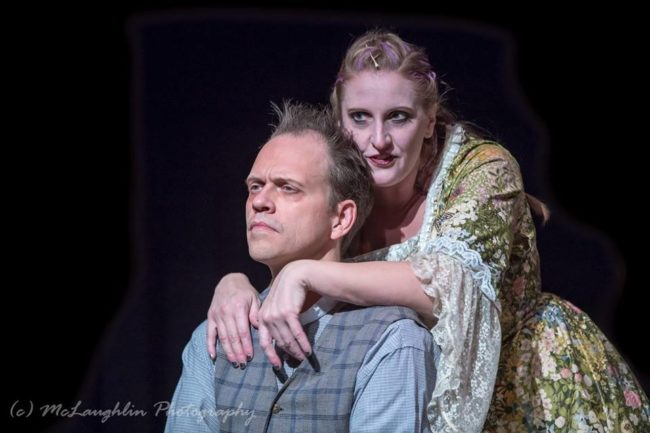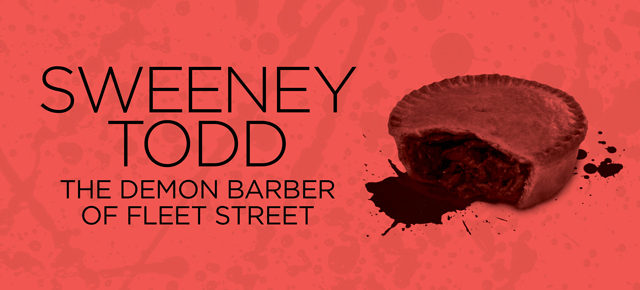God, that’s good! Yum…is that a pie fit for a king? A wondrous sweet— a most delectable thing! Well, I am no king (nor have I shaved the faces of any) but the pies in Kensington Arts Theatre’s production of Sweeney Todd: The Demon Barber of Fleet Street are to die for. Sit yourself at one of the rustically ill-sanded picnic tables just at the foot of the stage and if you dare (and are very lucky) you might just sneak a snack during the opening of Act II! Directed by Craig Pettinati with Musical Direction by Stuart Y. Weich, this newly remodeled eight-person rendition of Sondheim’s dark and murderous barber-turned-butcher, is in your face and frightfully present.

At first the show’s aesthetic looks questionable, even lackluster, but once the production gets away the deceptively simplistic scenic design, by way of Scenic Designer Jared Johnson, has a more industrial and functional feel and verve to it. With a simple (person-powered) turn-table fixture beneath the barbershop chair (and an excellent focus on the visual cues from the actors on stage thanks to Stage Manager Carol Jones and her run crew), the whirling disposal of bodies becomes a mechanism that not only looks cool but actively works to screw the cogs of the musical’s mechanisms into rotation.
What’s truly remarkable about the show’s aesthetic is not the costumes by Richard “Bat” Battistelli or the various and sundry special effects (including all of the fog) by Jeff Clausen (who also serves as the show’s Sound Designer) but rather the remarkable projections and streaming videography that Director Craig Pettinati has conceptualized and integrated into the performance by way of Lighting Designer Dan Patrick Leano. When various moments of recollection occur, rather than having live actors on stage, as is often the more traditional approach to this unique feature of Sondheim’s work, Pettinati and Leano pipe antiquated video footage, filmed in shades of sepia or black, white, and gray, onto the overhanging projection screen at the back corner of the stage. They also use this projection screen to display old-fashioned pictures and sketches throughout the performance to draw the audience into the various locales of the performance. And of course, Leano and Pettinati use the screen for the show’s gore factor, a tasteful splatter of the sanguine whenever someone meets their untimely end.
Properties Mistress Joy Gerst deserves a shout out for her work which is peppered liberally throughout the production, but particularly when it comes to those bloody delicious meat pies! Thin, flaky crust with bits of this-n-that inside? Simply to die for! Gerst also creates clever little bottles for Pirelli’s Miracle Elixir and does other nifty things in the realm of properties all throughout the show, including the key which Anthony receives of Johanna. There is no need for tittering twittering larks in cages as this character and scene have been cut from this production by Director Craig Pettinati.
The selective trimming of the fat in this production serves the show’s pacing well. Excluding the bird-cage scene as well as the entire scene at Fogg’s asylum keeps things moving as well as eases the strain and burden on the eight-person cast. With these casting choices, Brittney Bartlett is already doubling up as The Beggar Woman and as Pirelli and would be the only truly obvious choice to play Fogg and the Bird-Seller, which may overtax the actor. Pettinati fails to seize the opportunity to play with the gender fluidity of having a woman playing Pirelli, as Pirelli is unmasked to really be the young Irish individual who knew Benjamin Barker from the time before, and a simple flip of “lad to less” might make the illusion stand on firmer ground.
What’s questionable about Pettinati’s approach to the production is what he didn’t cut from the performance. Judger Turpin (Jim Adams) has a number in the middle of the first act, “Johanna (Part II)” which can make the skin crawl if done properly. The number in itself is a difficult piece of music as it is written to have the Judge flagellating himself for impure thoughts over his ward, Johanna. The overall nature of the number demands a darkness which most actors are either unwilling or incapable of expressing. Unfortunately, Jim Adams does not possess that darkness and the number just sits awkwardly there as he struggles through it with his fly unzipped, half meaning to imply the character’s impure thoughts. Adams is a far cry from what is expected for the character of Judger Turpin on the whole (give Adams’ much higher vocal range, his lack of stage presence and overall milquetoast resonance in the role) and it begs the question as to why Pettinati did not simply cut the number as it is one of the numbers that can be cut without question.
Despite the lackluster and musically mismatched Judge, the show is quite enjoyable, albeit dark. But those favoring Sondheim expect dark when they come to see one of his shows. Sweeney Todd is arguably the darkest, but that’s half the fun. The aforementioned Beggar Woman (Brittney Bartlett) is a fascinating on to watch, observing how she flip flops between stir-crazy street strumpet and a delicately misplaced lady whose mind has gone way of the meat pie. Watching her throughout the production is a delight and most rewarding when she comes face to face with Sweeney Todd near the show’s conclusion.
Toby (Emily Lawrence) is a sprightly young thing that just leaps about with a bit of pizzazz all through the first act of the show. Even the Act II opening number, “God, That’s Good!” features Lawrence’s spry step and energetic vocals bounding about the way a youthful character ought to do. The versatility that Lawrence displays, making his rendition of Toby truly impressive, however, is when Lawrence shifts into a more serious number, “Not While I’m Around.” This number is oft experienced as a plucky little song that puts a pound of courage on the table from the young and protective Toby character. But Lawrence’s performance of the song is heavier, darker, and loaded with a much weightier emotional gravitas.
Dripping with ingénue goo, both Anthony (Brian Dauglash) and Johanna (Simone Brown) possess the correct vocal qualities to play the lovebirds. Their chemistry from the meet-cute point is strong, albeit stagnant, and draws them together quite soundly. Both Dauglash and Brown have strong, sensible voices that deftly traverse the ridiculous scores of “Kiss Me” and its reprise as well as their various segments of “Johanna.” While there is nothing extraordinarily out of the ordinary about Dauglash or Brown’s performance, they are both vocally sound and full of that gushing ingénue-type love that clobbers the characters of Anthony and Johanna.
Here we have fop! Finest in the shop! Christopher Gillespie’s Beadle Bamford is campy and glee- hampered; he’s over the top! Arguably the show-stopping scene stealer, Gillespie is a proper scream in this production as Judge Turpin’s sidekick. This level of comedic villainy is both dark and hilarious, campy and yet genuine. The facial expressions and way Gillespie carries the body of Beadle Bamford are maddeningly entertaining and the vocal quality brought to the table during “Parlor Songs” is pure despite all the nonsensical framework that falls around it. Gillespie is a hoot; if there were a way to somehow split him in twain and dual-cast him as both Judge and Beadle…that would have made for true bombastic villainy that could have easily imploded the production in the best way imaginable.
Crass, coarse, and spot-on with her working class underbelly of London accent, Elizabeth Hester is quite the tour du force as Mrs. Lovett. The biting sarcasm, the scrunched facial expressions, the powerful belting sound that resonates through the hard-sung choruses of numbers like “A Little Priest”, all of these elements come together under Hester’s seasoned performance to create a Lovett that the audience loves to hate. There is no humanity or sympathy or weakening of the walls in Hester’s Lovett, which makes the final scene between her and Sweeney Todd truly gripping. With a keen sense of rhythm and timing, Hester aces “By the Sea” and “The Worst Pies in London.” The way she fusses over Sweeney Todd really grounds the Lovett character in the driving reality that she’s created for her. Hester’s Mrs. Lovett knows exactly what she’s doing; the calculating and conniving practices are ever so thinly veiled beneath her gritty exterior and it’s a brilliant choice that elevates the overall quality and feel of the show.
A ferocious performance with deep, soul-searing intensity, can forgive a multitude of sins, including a non-existent English accent. Accent or no, Hans Dettmar in the titular role is terrifying. There is a vacancy that resides just behind the actor’s eyes; the haunted memories of his past and how they have led him to exactly this moment in time are burbling just inside their glassy lens. And when Dettmar sings, it is sublime. Vengeance blended with tragedy and a whole amalgamation of indescribable woe rushes up through his performance of “My Friends.” And if you want to feel the thrill of fearing for your life, sit at the picnic tables at the foot of the stage because when he thrusts himself into the audience for “Epiphany” he’s nothing short of ghastly blood-thirsty creature ready to slack his lust for carnage on whatever or whoever happens to be before him. Astonishing in the role, and deeply invested in its narrative, Hans Dettmar takes Sweeney Todd and transforms him into the full label of the title, delivering a proper demon barber of Fleet Street in this production.
You may sail the world and see the wonders, but it would be a shame if you missed this production, for there’s no place like Kensington Arts Theatre when it comes to this particularly dark and violent Sondheim show.
Running Time: 2 hours and 45 minutes with one intermission
Sweeney Todd plays through November 17, 2018 at Kensington Arts Theatre located in the Kensington Town Hall— 3710 Mitchell Street in Kensington, MD. For tickets call the box office at (206) 888-6642 or purchase them online.

